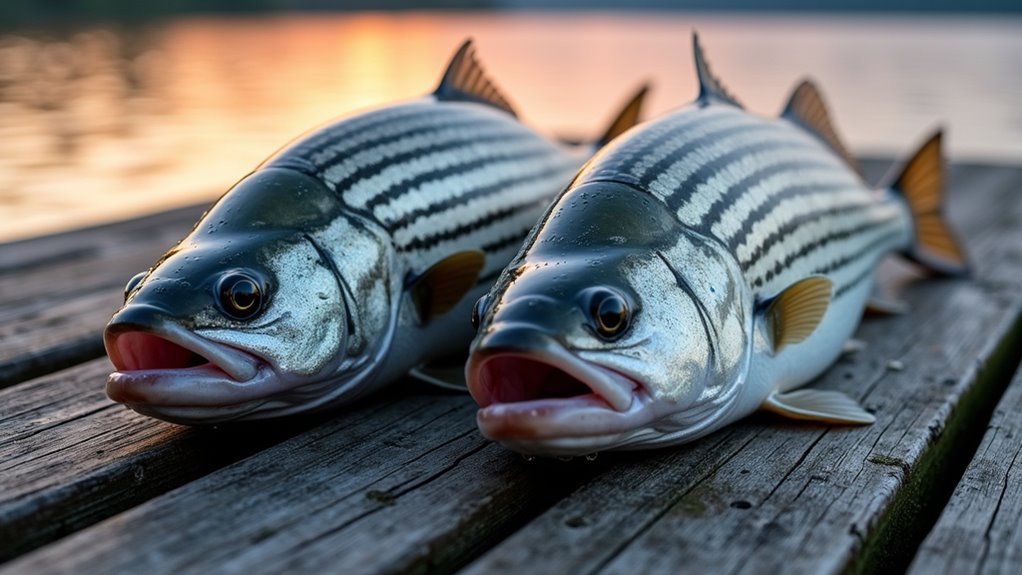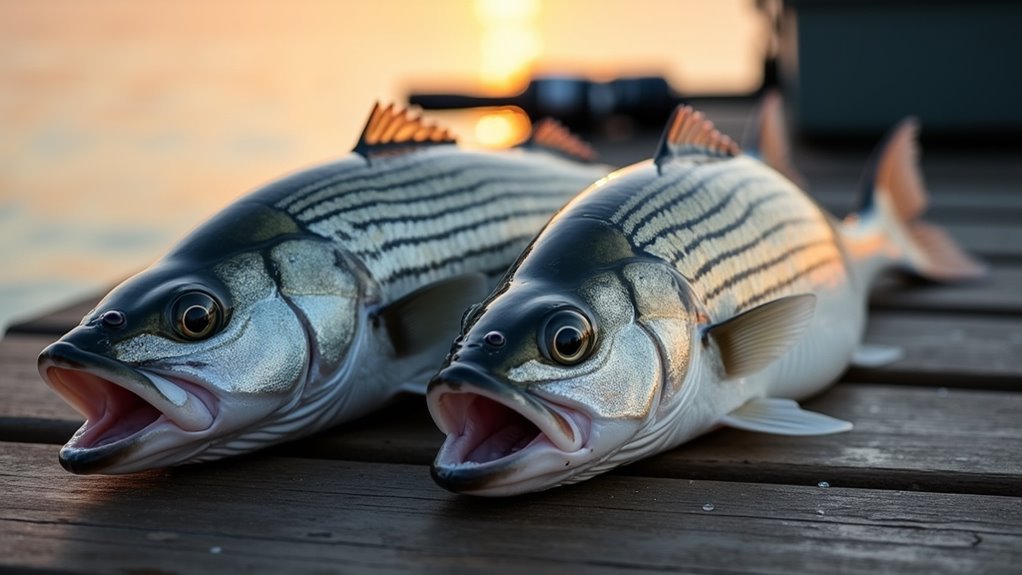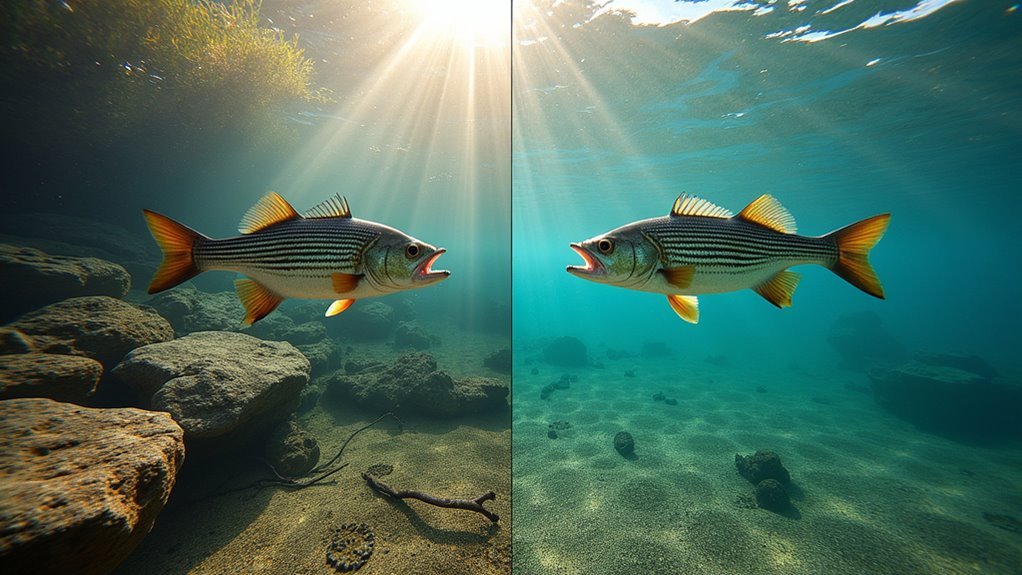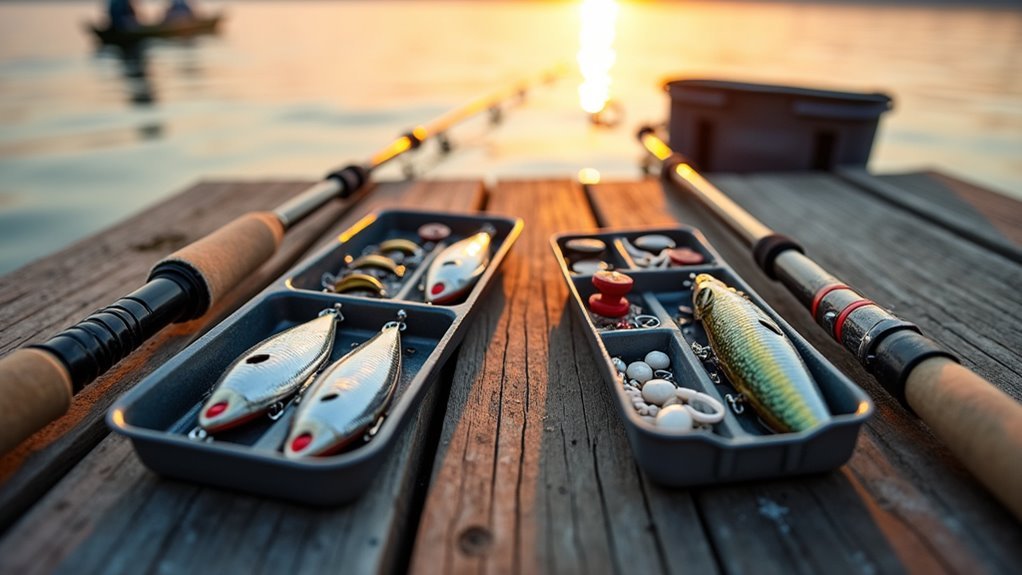While striped and white bass look similar, they’re actually quite different critters! White bass are smaller (under a foot) with fainter lateral lines, while stripers grow much larger (2+ feet) with pronounced stripes that reach the tail. We’ll find whites in inland lakes, while striped bass prefer saltwater environments and make spawning migrations. For tackle, we’ll need light gear for white bass but heavier equipment for those trophy stripers that’ll bend your rod double. Stick around to discover their unique tongue patterns that never lie!
Physical Differences: Shape, Size and Body Structure

When you’re out on the water trying to identify your catch, the most obvious differences between white bass and striped bass come down to their physical appearance.
We’ve seen countless anglers mix these two up! White bass are shorter and more compact, typically measuring just under a foot, with a rounded, vertical profile. They’re the scrappy little fighters that surprise you with their punch. Striped bass, meanwhile, have that classic torpedo shape and dwarf their cousins, averaging two feet and often reaching 25 pounds or more. Last summer, I pulled in a striper that nearly bent my rod in half!
Distinctive Markings and Visual Identification Guides

Although both species display similar silver coloration, the distinctive markings on white and striped bass are your best tools for proper identification. We’ve spent countless mornings squinting at our catches, and trust me, it gets easier!
Look at those lateral lines—stripers have pronounced lines running all the way to the tail, while white bass show just one less noticeable line. Check the tongue too! We once caught what we thought was a trophy striper, until we spotted those telltale tooth patches—white bass have circular patches, while stripers display two vertical marks. These little details have saved us from many fishing tale corrections!
Natural Habitats and Spawning Behaviors

While white and striped bass might look similar at first glance, they’ve carved out quite different lives in our waterways. We’ve tracked these fighters to completely different homes – whites prefer inland waters while stripers love that saltwater connection.
- White bass thrive in lakes, ponds, and gentle rivers across North America
- Striped bass are primarily Atlantic dwellers that need access to saltwater
- Whites spawn over rocky areas in springtime river runs
- Stripers are anadromous travelers, making impressive upstream migrations
We’ve seen white bass absolutely boil the surface during spring spawning runs, while stripers gather where fresh meets salt.
Fishing Techniques and Tackle Selection for Each Species

Anglers looking to target these bass species need distinctly different approaches in their tackle box. For white bass, we’ve found lighter tackle works best, especially when they’re schooling before spawning. Small grubs, tubes, and crankbaits in the 2-3 inch range trigger those aggressive strikes.
Striped bass demand heavier gear. We once hooked a 20-pounder where the Santee meets the Cooper – nearly spooled us! Sandworms, shrimp, and larger swimming plugs work wonders, particularly in current seams where fresh and salt water mix.
Frequently Asked Questions
Are White Bass and Striped Bass Good to Eat?
We find both white and striped bass are good eating fish. They’re mild-flavored and flaky. White bass can be slightly stronger tasting, while stripers are often preferred for their firmer meat.
Can Striped Bass and White Bass Naturally Hybridize?
Though 95% of hybrid striped bass are hatchery-produced, we’ve found they can naturally hybridize in waterways where their spawning grounds overlap. Natural hybrids are rare but scientifically documented.
What’s the World Record Size for Each Species?
We don’t have specific world record data in our information. Generally, striped bass can reach 25+ pounds and exceed two feet, while white bass typically stay under a foot long.
How Can You Identify Juvenile Striped Versus White Bass?
Could it be that shape tells us more than size with juveniles? We’d identify young stripers by their torpedo shape and unbroken lateral lines, while white bass appear rounder with less distinct markings.
Do White Bass and Striped Bass Compete in Shared Waters?
Yes, white bass and striped bass do compete in shared waters. We’ll find them competing for similar food sources, especially when their habitats overlap in rivers and reservoirs.
Conclusion
We’ve barely scratched the surface of these remarkable fish, but we’ve armed you with the knowledge to confidently identify your next catch. Whether you’re battling a hefty striper or reeling in a spirited white bass, the thrill never fades. Next time you feel that familiar tug on your line, you’ll know exactly what’s fighting on the other end. Until then, tight lines and calm waters, friends!